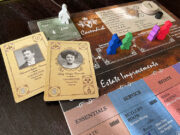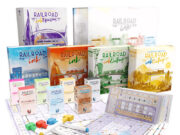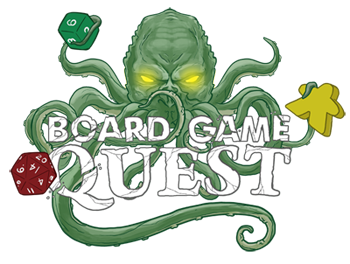 There is a formula to many Euro games, especially ones that are medium weight and play 2-4 players. Honestly, it’s so deliberate that once you play a handful of them, especially ones from the last 10-15 years, you’ll start to see the underlying design work and then just be expecting it. Here’s what it is broadly: a central action mechanism with a slight puzzly component that gives access to a variety of actions.
There is a formula to many Euro games, especially ones that are medium weight and play 2-4 players. Honestly, it’s so deliberate that once you play a handful of them, especially ones from the last 10-15 years, you’ll start to see the underlying design work and then just be expecting it. Here’s what it is broadly: a central action mechanism with a slight puzzly component that gives access to a variety of actions.
These actions are separate systems which either dictate a variety of ways to generate points or upgrade other actions. All of this usually results in point salad style scoring from the subordinate activities the game offers. One of the most iconic examples of this is Trajan (Feld, 2011), which is not to say it’s bad, but it definitely provides a formulaic method for Euro gamers to enjoy in different guises.
There’s another game, which came out the same year as Trajan, which also follows this formula. The name’s in the article title. Does this formula ensure gaming enjoyment? Well, in this review, we’ll take the revision to Kraftwagen (Cramer, 2011) for a road test. It’s got a new subtitle: “Age of Engineering” and, expectedly, it’s 2-4 players, 90 mins, and best with a full player count.
Gameplay Overview:
As the introduction mentions, there’s a main action mechanism and some subsystems that trigger off that. Let’s go through them.

The action gear in the middle of the main board has a line (queue) of action tokens depicting various things you can do in the game. It also has a set of player tokens arranged serially. The middle of the main board contains an action gear with a queue of action tokens that show the different actions that can be taken throughout the game. The action gear also includes a queue of player tokens. The player whose token is at the end of this line is always the next one to take their turn. They select any action token in the line and replace it with their token. Then they move that replaced token to the beginning of the line (the front end). The action token the player moved gives the player the chance to do that specific action. So, what are the actions?
- Research – Each player has a technology level for their Car Body and Car Engine. When doing this action, a player will increase the level of either of these.
- Build a Car Body – Take a Car Body tile and place it in an available workshop on your player board (the player board has three of these).
- Build a Car Engine – Take a Car Engine token and place it in one of your available workshops (the player board has three of these) or into your Race Car’s engine.
- Hire Workers – Collect workers from the supply in your color to aid in selling cars and supporting sales.
- Recruit – Take one tile from the pool of recruitment tiles. These usually give you upgrades to actions (Engineers), instant effects (Bonuses), or, with Investors, special car buyers with unique interests.
- Attract Buyer (Marketing) – Another side of the board has a set of buyer tokens. Taking this action puts one of the buyers into the active market. At the round end, this buyer’s priorities will determine which car they buy.
- Grand Prix (Race) – Move your Race Car on the track as many spaces as your Race Car’s engine plus a bonus depending on how many workers you have added to your player board racing team spaces.
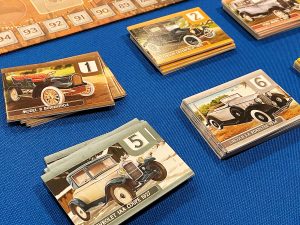
There’s one more action which is really just an add-on action after your main one: Put a Car into the Active Market. This is done by taking a Car Body from one of your workshops and a Car Engine from another of your workshops. Then workers are required to be added to support the car. Additionally, the player takes a Price Token and puts it on the car.
At the end of the round (when all spaces of the active car market are full or all active buyer spaces trigger the end of the round), the round ends. Each buyer’s needs are evaluated against cars in the market depending on the Engine Level, Car Body Level, and number of workers (for luxury car buyers). For example, a buyer interested in a car with the highest engine level will buy that car for the price listed. The player gains a number of points equal to the price. If there is a tie, the winning car is the one with the lower price. Also, at the end of the round, the players whose cars are in the lead of the Grand Prix (1st, 2nd, 3rd) gain points as well.
After three rounds, the game is over and the player with the most points is the “best” car company?
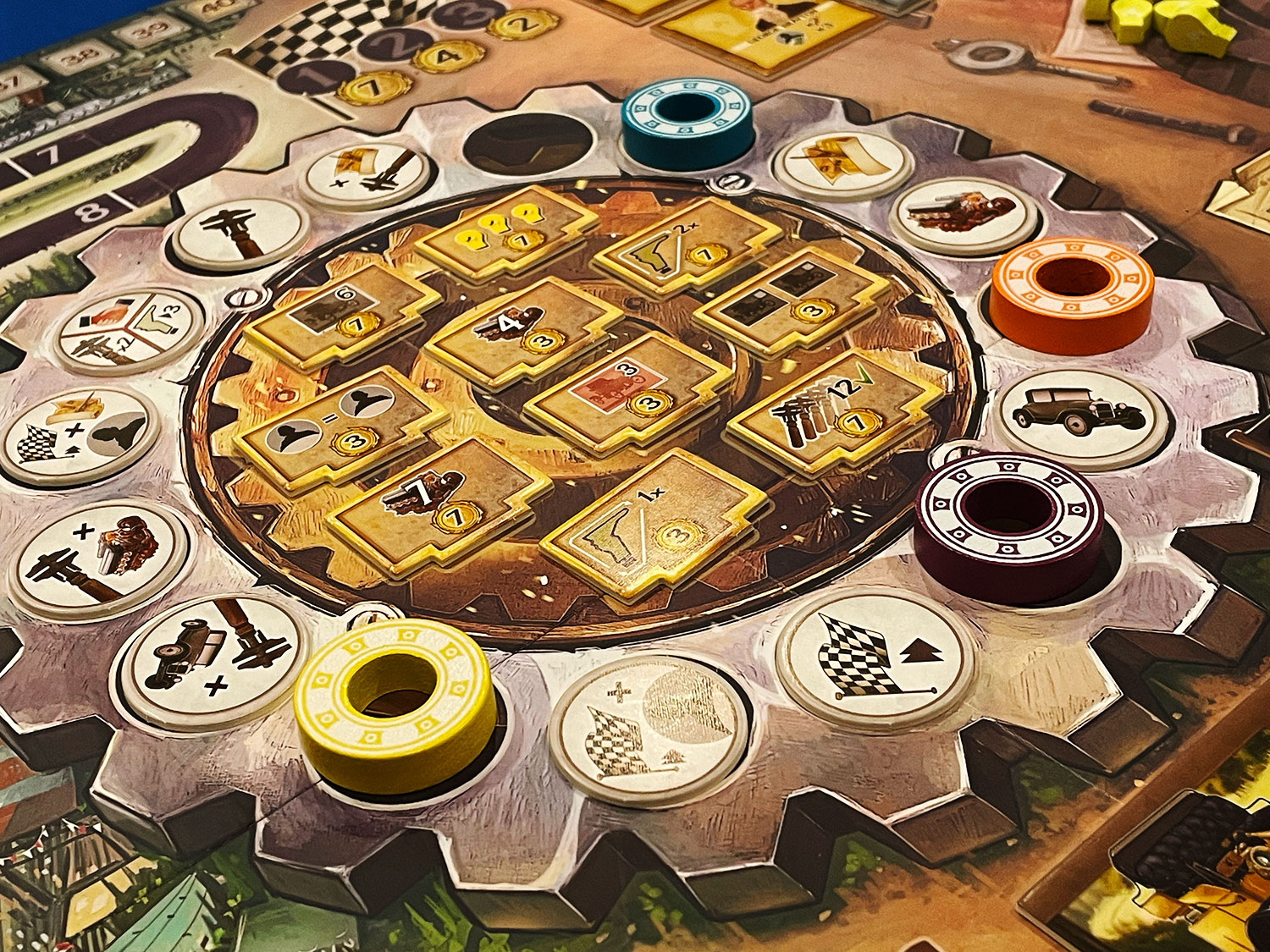
Game Experience:
Players who have never played a medium-weight Euro game made in the last 15 years will most likely find Kraftwagen: Age of Engineering to be an engaging and dynamic experience with lots of options and challenging decisions. However, once the clear coat of cool from the action mechanism wears out, players will start to see that it’s actually just a limited rondel where similar choices from players push those same options for other players out of reach.
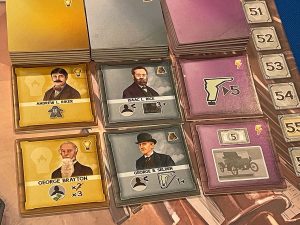
In that sense, timing and strategy are key to getting the most from actions. However, you can also play pretty methodically, just gobbling up action after action consecutively, and the result can be largely the same. The action wheel with the last player always taking the current turn is a mechanism that works for some games, but in Kraftwagen, the comparative value for most actions is so close that many times the choice is 6 of one, half a dozen of another.
The exception to this are a few actions which dramatically determine which cars are sold. Players should keep a focus on this each round because they are important for getting the larger points round end. At the beginning of the game, the Grand Prix race looks attractive and fun, but by the end of the game, the point balance usually favors cars sold in the marketplace. So, the game ultimately shines with players new to the hobby who can suss out the best actions each round through a basic set of mechanisms to experiment with.
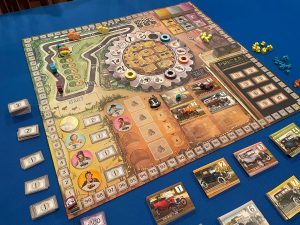
Unfortunately, the included rules are not the best at helping new players understand the game. Overall, the rules are fine, but there are a couple of places with game terminology that desperately needs to be cleaned up for ease of instruction. This may be a result of a too precise (or maybe at times inaccurate) translation from German, but in either case, it complicates what should be a relatively easy game.
The final pothole for Kraftwagen is the game length. It’s not that the game is too long, but rather that it overstays its welcome. For seasoned gamers, the game can feel repetitive, with many options feeling irrelevant or overdone by the third and final round. The best way to describe it is that the amount of effort for points feels very high comparatively with other games. Here, lining up all the right actions to sell a car feels like an immense achievement, but then to have it not sell in the market is a big letdown. So, experienced players will steal sales compared to newer players, and it doesn’t make for players who enjoy effort rewarded over the struggle of competition.
Final Thoughts:
If you are new to modern board games, you should try Kraftwagen: Age of Engineering. It’s got the complete experience of what the board gaming hobby is about, both good and bad, in one package. There are times when hopes are high given a revision to a title like this, but there are just as many design detours and roadblocks that make the result problematic. If players are willing to deal with some bumps in the road, they should check out this ride.
Final Score: 3 Stars – Sleek modern production design is hampered by an action mechanism that mellows the competition.
 Hits:
Hits:
• New art and production design is energetic
• Easily helps new gamers learn some cool Euro mechanisms
Misses:
• Confusing rules with vague wording
• Strategic play doesn’t outstep purely mechanical play
• Rounds are too long for the decision weight




